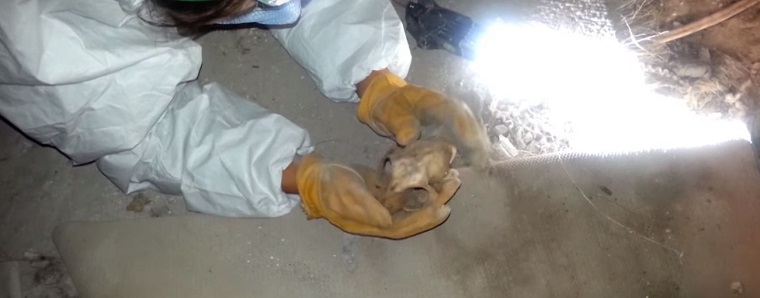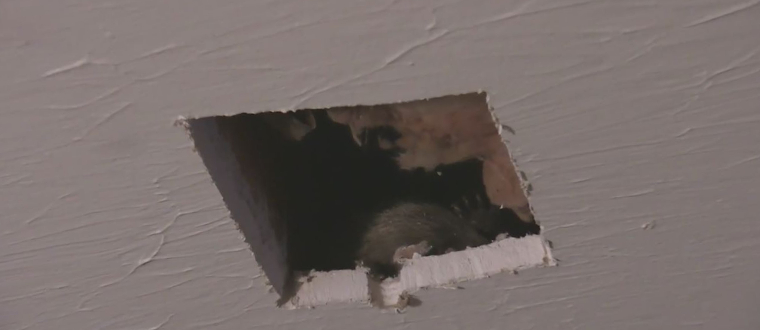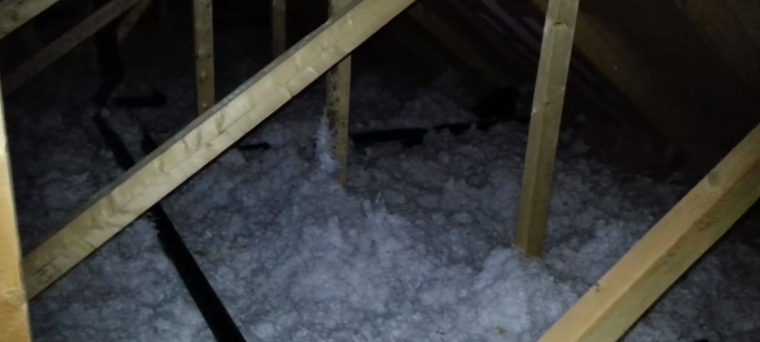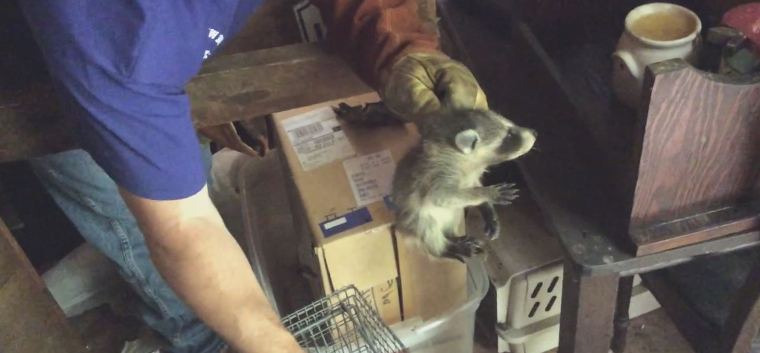-
info@aaanimalcontrol.com
Call us for help in your town
Humane Wildlife Education
Why do raccoons die inside houses or attics?
Need raccoon removal in your hometown? We service over 500 USA locations! Click here to hire us in your town and check prices - updated for year 2020.
Raccoons are quite large creatures, so one of the biggest reasons behind them dying inside a home or attic is because they have managed to get stuck somewhere. This could be in a tight squeeze spot under your home, or maybe even in one of the wall cavities, another prime spot for animal invaders.

Raccoons might also die in your home if you have sealed up recently. This is why you should always ensure that all animals have been properly evicted from your land before you seal up all the holes to make sure they can't come back. If you seal up too soon, you're just locking them in. If they're locked in, they can't get out. They probably won't be able to find food, or water, and they could starve to death, overheat (in the summer), or maybe even suffer with dehydration.
Learn if raccoons live in trees or sleep in trees.
Learn more if poisoning raccoons is beneficial: Is It Okay to Poison Raccoons?
If you have found dead raccoon babies in your home, there is a good chance that you evicted the mother without her young and, unable to get back in, she was unable to move them, feed them, or care for them. Without the care and protection of their mother, these wild pest babies are basically useless. They are unable to feed or take care of themselves, so die in their nests.
Find out: Are raccoons dangerous to cats, dogs, or other pets?
In short, one of the biggest reasons behind raccoons dying inside houses or attics is human intervention — when we try something to get rid of them that goes horribly wrong. Poison is another way that can lead to this outcome, especially when talking about the raccoon. There isn't a registered poison for this animal, so made-up combinations of ingredients are often used, and this is a dangerous combination for the local wildlife and plants, alongside the original creature that was initially being targeted.
We can answer: What to do if you are bitten by a raccoon
In order to make sure your home is wild animal-free, you must do things the right way. It's often the longest way, and the most time-consuming in many cases, but it doesn’t reduce the chances of you ending up with a bunch of dead animals on your hands.
For more information, you may want to click on one of these guides that I wrote:
How much does raccoon removal cost? - get the lowdown on prices.
How to get rid of raccoons - my main raccoon removal info guide.
Example raccoon trapping photographs - get do-it-yourself ideas.
Raccoon job blog - learn from great examples of raccoon jobs I've done.
Raccoons in the attic - what to do to solve the problem.
Read more dead animal carcass removal articles here:
Does a dead animal carcass cause flies?
A dead animal inside the air conditioning ductwork
What to do if I find roadkill - a dead animal in the street?
How long does it take for dead animal odor to go away
How to properly dispose of a dead animal carcass
What to do if I find a dead deer outside?
What to do if I find a dead dog?
Can a dead animal cause any diseases or health problems?
Why do animals die inside a house?
What to do if you have a dead animal under your house
Why do rats die inside houses or attics?
Why do raccoons die inside houses or attics?
Why do opossums die under houses?
Can Repellents Get Raccoons Out of The Chimney?
I Have a Nest of Raccoons in the Attic, What Next?
Dead Raccoon Removal - The Complete Guide
Need raccoon removal in your hometown? We service over 500 USA locations! Click here to hire us in your town and check prices- updated for year 2020.
If wildlife is rife in your local area, there's a very good chance that you'll come up against a dead animal at least once. This might come in the form of roadkill, or perhaps dead rats in rat traps scattered around the back yard. Sometimes, you will be unlucky enough to experience dead wildlife in your home.

There are a number of things that will lead to dead animals in or around your home or building. In the wild, even the best conditions can't give this animal a life that is longer than around four or five years. In fact, many raccoons don't actually make it past the age of two or three.
Disease will be a big killer of raccoons, and natural predators, such as coyotes, wolves, foxes, and bears, will take them down in more wild habitats. As they come closer to human populated areas, vehicles will be the number one killer, especially as raccoons are well-known for going after other animals that have previously been involved in vehicle collisions. Vehicles are closely followed by people — trapping, poisoning, and other incorrect removal methods actually end up killing more raccoons and other wild critters than you'd think.
How will I know if I have a dead raccoon in my home?
You'll know within a couple of days — the smell will soon give the game away. You might not see that creature. In fact, you might have breathed a sigh of relief. Your removal and repelling tactics appear to have worked, because you haven't heard the oh-so-familiar scratching, scuffling, and thudding sounds you had started to associate with the scavenger.
Sadly, there's a higher chance that the raccoon has died than been repelled. There are very few repellents that work for any wild animal or pest animal invasions.
How to find a dead raccoon in my home
You'll need to let your nose be your guide. The more concentrated the smell, the closer you are to the carcass. In the back yard, look in places such as under decking, balconies, porches, and other outbuildings. You should also look in tree hollows, tree and rock piles, and other areas of debris. If disease or predatory attack has taken the critter down, it might not have made it back to your home before it passed away.
If the smell seems to be coming from inside your property, look in the attic and crawl spaces, as well as in the basement. While you're in the attic, you should see whether or not you can get a good view into the cavities of your walls. Pest animals seem to get stuck in there a lot, and when they become stuck for longer than a few days, they die.
Chimneys are hard-hit areas for raccoons, alongside other quiet and dark spots in the roof.
If you can smell the carcass but can't seem to find it, there is a chance that the animal is in a place that you can't easily get to, such as wall cavities that aren't accessible from the attic. If this is the case, the next part of the job gets much messier and more difficult.
How to remove a dead raccoon from inside the walls
If you can't get to the cavity in your wall from the attic looking down, you might need to cut a piece of your wall out to reach into the space behind. This is a big deal — major cosmetic work. You will need to make sure you know with absolute certainty where the creature is BEFORE you start cutting. You'll end up with a lot of holes in the wall otherwise.
Alternatively, give wildlife removal experts a call. They're good at getting the right spot the first time. (Just one of the benefits from hiring someone who has done the job many times before.)
5 Signs That You Have Raccoons in the Attic
Need raccoon removal in your hometown? We service over 500 USA locations! Click here to hire us in your town and check prices- updated for year 2020.
In some cases, home and property owners are aware that they have some sort of animal invader in the attic, but may not be aware of what that animal actually is. This makes it difficult when it comes to removing them, of course, because there are so many different options, many of which need to be tailored for that specific animal. Different animals will also have different laws attached to the removal and destroying of them, so you will definitely want to know which critter you're up against before you start any removal action.

If you suspect that you might have a raccoon up in the attic, there are five massive tell-tale signs that you need to keep your eyes peeled for ... and maybe throw a few of your other senses in while you're there!
5 Signs That You Have Raccoons in the Attic
1 - Raccoon Sounds
You will, without a doubt, hear these creatures before you see them. They don't care who they wake up, how much noise they make, or how much noise you make trying to get rid of them. Being nocturnal by nature means that they will sleep the majority of the day away, eliminating the chances of you hearing them. They are still active during the day form time to time, but they are the most active at dusk and dawn. These are the times at which they would leave the den and then return again.
Scuffling, banging, thudding, calling, squeaking, growling, hissing, and all sorts of other noises have been associated with raccoons, particularly those in the attic. The acoustics tend to be pretty good up there, so the noise of these creatures is amplified, especially when everything else is dead silent around you.
2 - Raccoon Skat
“Skat" is just another name for raccoon poop, and this stuff is more dangerous than you might first think. The list of diseases linked to raccoon skat is long, and some of them can actually be fatal to both humans and other animals alike.
Raccoons tend to leave their waste in bathroom-style areas, usually referred to as latrines. If you find a latrine, you know that you are close to their den site or home, but not too close. Although not really known for their high levels of hygiene and cleanliness, raccoons don't like to poop where they sleep or eat.
The more pale and dusty, the longer the poop has been there, and the more dangerous it is too. There is some evidence to support the theory that minuscule roundworm eggs can be sent into the air and then inhaled once the skat has turned dry and dusty.
Raccoon poop can look a lot like cat or dog poop, especially when the animals are around the same size. There are a few differences — raccoon skat tends to have some remnants of food left in it, such as berries or tiny little bones.
3 - General Mess
Raccoons are destructive as hell once they get started, and they don't care how much damage they create in the process of finding food. You really couldn't list the amount of ways that these creatures could utterly destroy your back garden, but the following have been documented by homeowners and commercial property owners alike:
- Knocked over garbage cans & garbage strewn all over the place.
- Holes in lawn, caused by raccoons digging for insects.
- Entire areas of plant life destroyed.
- Dead fish in ponds.
- Fruits torn from trees.
- Bird feeders destroyed & the seeds/nuts within it devoured.
- Torn siding.
- Chewed wires.
- Torn holes in roof/ceiling.
We could continue to list raccoon damage, but we're pretty sure you get the general idea — they're a menace!
4 - Paw Prints
Tiny paw prints and other physical signs can often give the game away, especially in ground coverings that are soft, dry, slightly moist/wet, or dusty. Raccoon paw prints look like the paw prints left behind by cats or dogs in some cases, and you might easily confuse them. You shouldn't; however, your pets are nowhere near as dangerous to your health as raccoons are.
5 - Raccoon Smell
Most wild animals have a weird and musty smell about them, and there's a good chance that, just like you'll hear these animals before you actually see them; you'll smell them too.
A live raccoon can smell just as bad as a dead one, and if you've ever had a dead animals in your home, you'll know just how bad that can smell. When raccoons get in the air conditioning units and other places in your home that are known to circulate air, the smell can easily get around, and that musty, dirty, wild animal smell might just drive you crazy in a few days, especially if you can't find the source of it.
Can You Get Raccoons Out of the Wall Through the Attic?
Need raccoon removal in your hometown? We service over 500 USA locations! Click here to hire us in your town and check prices- updated for year 2020.
In around a quarter of all cases, wild raccoons that have fallen into the cavities and voids of your wall and gotten stuck will be reachable from the attic, looking down. In more cases, however, you will be unable to get to the animal in this way. When you can't reach the animal by making your way into the attic first, the only other way that you will normally have to get raccoons out of the wall, is to physically cut a section out of the wall.

We know what you're thinking; the wife is going to go mad! Sadly, when you allow raccoons to get into your home or property, you are allowing them to get ANYWHERE they want. These spots are going to inconvenience you greatly when it comes to getting rid of the animals, and it's not like you can just leave them there; they spread disease and cause destruction and damage on a massive scale.
The Attic Method
If you believe that you have raccoons in the wall, either because you have heard them scuffling around in there or because you can smell something musty or bad (a common sign that you have wild animal invaders), we recommend heading up into the attic.
Sometimes, if you're very lucky, when you do go up there and look down in between the beams and attic insulation, you might just find a direct path to the animal that is sat beneath you. If the animal isn't too far down, you might be able to reach it (or the nest) with a well-protected hand. (Thick rubber gloves are a very good idea to prevent against scratches and bites.)
If the animal is further down than what you can reach, a snare pole will come in handy. These are long poles with a snare at the end, just as the name would lead you to believe, and are handy for reaching animals that can't be reached any other way. Sadly, the incidences of people accidentally injuring or killing animals using a snare pole trap are increasing, so this is not a method that we recommend you choose if you don't really know what you're doing. (You're not expected to, in your defence.)
Most wildlife rehabilitators and pest removal experts will have access to snare poles and will be both trained and insured/licensed to use them.
The Wall Method
When you head up into the attic and CAN'T see the raccoon or family of raccoons hanging out in your wall voids, drastic measures are called for. There is a very good chance that you will need to cut a square section out of the wall, just to get to the furry beasts behind.
Obviously, when you're cutting an actual section out of your wall, you're going to want to make sure you get the place right first time. Use your nose, ears, and hands to see if you can smell, hear, or feel for the animals. The nest area is likely to be warmer, something you might feel on the external side of the wall. The smell of wild animals are pungent too; raccoons are known to have quite a musty and obnoxious smell. You'll already know what they sound like — you've probably been listening to them for some time.
The process is very simple; cut the wall, use gloved hands to retrieve the family and hope they don't run off while you're doing it, stick them all in a trap and then repair the wall.
The reality of using this process is usually VERY different — the animal(s) can scurry off further into the walls of your home as you make lots of noise to cut the wall. You might injure or kill the raccoon or raccoon kits during the cutting process, which is going to be just as traumatic for you as it will be for the animal. You could even cut the wrong part out of the wall and then need to make it bigger to actually reach the animals.
Once you do manage to get those raccoons out of your wall, you will then need to repair the wall and redecorate it again, attempting to make it look like you did before.
The Wildlife Rehabilitator Method
There is a third option, of course; you could hire in wildlife rehabilitators to do the job for you. You might even find that it works out a lot cheaper … especially if you keep cutting the wrong part of the wall out.


















